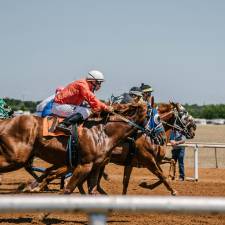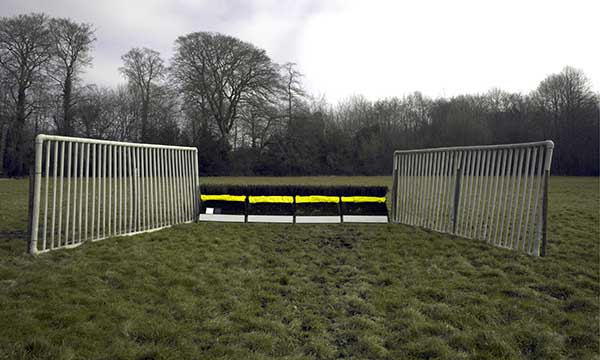
by The British Horseracing Authority
Scientific research into equine vision leads to trial of new fence and hurdle design to further improve safety in jump racing.
The research by University of Exeter shows that horses see better and may jump differently over white and yellow obstacles compared to the orange currently used on hurdles and fences.
The recommendation to trial the use of fluorescent yellow for all hurdles and guard-rails, and fluorescent white for take-off boards at fences is approved by Racecourse Committee.
The trial will be rolled out first at training yards before being used in a live racing environment, and has the objective of making jump racing safer for horse and rider.
The research will be shared with other jurisdictions and equine pursuits.
The colours deployed on hurdles and fences on British racecourses may be set to change off the back of cutting edge research led by the University of Exeter into the way that horses perceive colour.
In 2017 the British Horseracing Authority (BHA) and Racing Foundation commissioned – and provided funding support for – research into equine vision. The opportunity for this project was identified by the partnership between the BHA and RSPCA who work together on an ongoing basis to develop new ways to make hurdle and fence design safer.
The research was undertaken by Dr Sarah Paul and Professor Martin Stevens of the University of Exeter with the aim of improving obstacle visibility for the equine athlete, therefore enhancing the welfare and safety of horses and jockeys through reducing the risk of falls and injuries.
Presently, the colour used on hurdle frames and fence take-off boards and guard-rails is orange, based on human vision. However, horses have reduced colour vision compared to humans, and only differentiate objects in a palette of blues and yellows. The new research shows that other colours should be more effective in offering visibility to horses.
How humans perceive a fence compared to a horse.
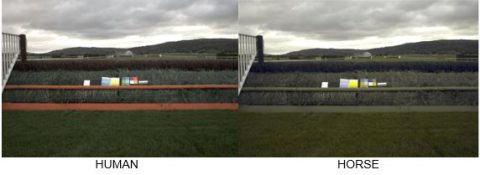
As a result of the research, a recommendation has been approved by the sport’s Racecourse Committee that a phased trial should be carried out using fluorescent yellow for all hurdles and guard-rails, and fluorescent white for take-off boards at fences. These colours have been determined to maximise visibility under a wide range of conditions for both humans and horses.
The proposed new obstacle colours which will be trialled at training grounds.
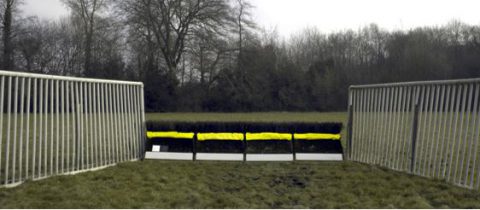
How humans perceive the proposed yellow colour compared to a horse.
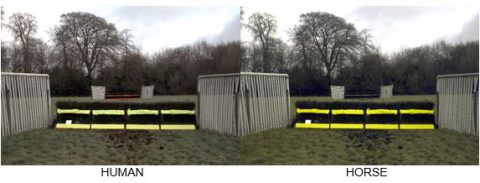
The research phase of the project included testing the visibility of orange markers and other potential colours at 11 racecourses, and – in collaboration with trainer Richard Phillips – testing the behavioural responses of horses to more prominent colours in a controlled environment. Retired jockey Ian Popham and conditional jockey Danny Hiskett acted as riders of the horses throughout the trial.
It has now been agreed that the next phase of the project should see a more extensive trial take place at training grounds in order to build up a significant dataset before rolling the trial out to a live racing environment.
The results of this research and the ongoing trials will be shared with other racing jurisdictions and equine organisations.
At the same time, the BHA and RSPCA are continuing to work together on a project to see if any further improvements can be made to the construction of hurdles, alongside the different use of colour.
David Sykes, Director of Equine Health and Welfare for the BHA, said:
“This fine and important project is an example of how British racing uses advanced scientific and veterinary research to constantly improve racehorse welfare, not only for thoroughbreds in Britain but across other nations and equine disciplines.
“As with the ongoing phased introduction of our padded hurdles – which have proven to reduce faller and injury rates – we will ensure to take our time with this project, make sure there are no unintended consequences and that the evidence of the ongoing trials continue to support the case for change.
“If that proves to be the case then we will look forward to seeing the new designs of hurdles and fences on racecourses, and hopefully further reducing our already declining faller rate.”
The faller rate in British racing has reduced by 29% since 2004 as a result of ongoing investment in racecourse safety, and constant enhancements in racehorse care and training standards.
Professor Martin Stevens, Chair in Sensory and Evolutionary Ecology for the University of Exeter, said:
“Understanding how animals see the world, and using cutting edge tools to investigate this, has a valuable role to play in guiding the safety and welfare of animals and humans in a variety of contexts. This project demonstrates how modern science can look to have widespread positive implications in human society and our interactions with animals.”
Caroline Davies, Racecourse Services Director for the Racecourse Association (RCA) said:
“Safety of all participants both human and equine is a priority for racecourses. We are always open to any initiatives that enhance safety and therefore endorse trialling the recommendations arising from this specialist research into equine vision, specifically as it pertains to the racecourse environment. We look forward to supporting the trials and working with our industry partners through the different phases.”
Ian Popham, Grade 1 winning former jockey who was involved in the trial, said:
“From riding over the different coloured fences it was clear to me that over some colours the horses reacted differently and showed the obstacle more respect. I’m sure other riders will feel the same and this feels like a great idea and opportunity to make the sport safer for both horses and jockeys.”
Rupert Arnold, Chief Executive of the National Trainers Federation (NTF) said:
“This fascinating research applies science to fence design. As it holds the potential to reduce fallers and so make racing safer for our horses, the NTF is in full support.”
Rob Hezel, Chief Executive of the Racing Foundation, said:
“By granting funds to ambitious and innovative projects, the Racing Foundation is working to achieve a better sport for all its participants. We believe that through investing in research, we lay the foundations for informed decisions and improvement in our sport. This project has done exactly that and we are delighted to hear that its findings have received such a positive response from key stakeholders and that they are now working together to take it forward and evaluate it in practice.”
Notes to editors:
1. Project summary
Horses (dichromats) see a reduced number of colours compared to humans (trichromats). They cannot distinguish between many of the colours humans see as red, orange, and green.
Analysis for horse vision was conducted to assess the contrast of the orange markers currently used on fences and hurdles from 11 race courses, and compared to the visibility of a range of potential alternative colours. Investigations were also conducted as to how this was affected by weather conditions.
- Orange was confirmed as having decreased visibility and contrast for horses against a range of natural and obstacle backgrounds.
- Yellow, blue, and white are more conspicuous against fences and their surroundings (foreground/background) than orange, especially yellow fluorescent colours.
Results were consistent under different weather conditions and time of day, except that yellow becomes less visible against the foreground turf under shade, whereas blue, white, and orange are more visible under shade. This effect of shade does not occur for other parts of the fence/hurdle, whereby fluorescent yellow remains most conspicuous.
The jumping responses of horses to fences with orange, yellow, blue, or white take-off boards and guard rails was tested.
In the behavioural trials, horses responded to different fence colours and the colour of the fences plays a role in both the angle that horses jump a fence and the total distance. Horses adjust their jump angles with colours that are different to orange, and white tends to produce a longer total jump distance.
From the combined results of this study, two potential recommendations were made for improving the visibility of fences and hurdles to horses.
- The simpler option is to use fluorescent yellow for all hurdles, take-off boards and guard-rails. This is predicted to provide the highest visibility under most conditions. However, the exception is under shady conditions at the base of fences, where yellow may decline in visibility.
- The alternative recommendation, which if practical is likely to combine the best features of visibility and horse responses under a range of conditions, is to use fluorescent yellow for all hurdles and guard-rails, and fluorescent white for take-off boards. This maximises visibility under all conditions while potentially facilitating better behavioural responses.
The Racecourse Committee subsequently reached agreement trial option 2, the fluorescent yellow hurdle frames and fence guard-rails with a white take-off board.
A project group will now be created to manage the roll out of the trial on training grounds in a range of geographical locations, with a decision to be made on how the trial will then be extended to a live racecourse environment based on the results of this training ground trial.
2. British jump racing faller rates:
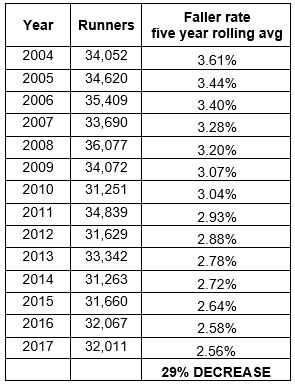
3. About the Racing Foundation
The Racing Foundation was established in January 2012 to oversee the distribution of funds to charitable causes within racing following the sale of the Tote. The British Horseracing Authority, the Horsemen’s Group and Racecourse Association are the three joint Members of the charity, which is registered with the Charity Commission as a charity under the law of England and Wales (no. 1145297).
The Trustees of the Racing Foundation are: Ian Barlow (Chairman), Linda Bowles, Susannah Gill, Mark Johnston, Jane Keir and William Rucker. Since inception, the Racing Foundation has granted just over £10million to charities associated with the horseracing and Thoroughbred breeding industry in the UK, supporting work in social welfare, education, training and participation, horse welfare, equine science research, and heritage and culture. Website: www.racingfoundation.co.uk Twitter: @RacingGrants
Find out more about Jump Racing in our section on Steeplechase.









